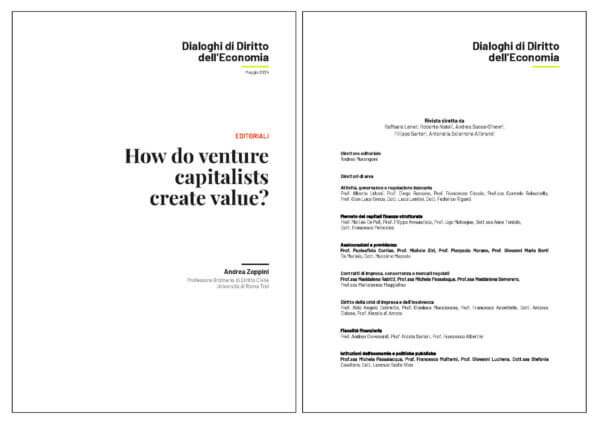Venture capital is a segment of private equity industry that specializes in selecting fast-growing projects and providing the necessary support for their implementation on financial as well as on non-financial grounds – in the form of managerial expertise, mentoring and networking.
Specifically, venture capital is an early-stage financing method, as it operates to support the process of developing an innovative idea (seed financing), the production of an already developed innovation (startup financing) or the distribution of the product to the market (first-stage financing).
Venture capital is physiologically highly risky. First, investment is generally linked to the development of new business ideas, products or technologies that have not (or not fully) been tested. Second, the success of the initiative crucially depends on the ability of the entrepreneur, who is often young and lacking experience. Finally, in most cases, and especially regarding intangible investment, the entrepreneur is unable to provide adequate capital guarantees.
In addition to the physiological uncertainty about the economic success of the financed business, the venture capitalist faces the strong information asymmetries and the significant agency costs that characterize the relationship with the entrepreneur.
Although the problem of information asymmetries is common to any relationship between a company and its investor, it is particularly relevant in venture capital. The innovative nature of the business financed significantly widens the gap between the information available to the entrepreneur – who dominates the idea behind the project and the methods of its technical implementation – and that which the venture capitalist can obtain on his own initiative. The problem arises especially at the genetic stage of the financing relationship, when the venture capitalist must evaluate the uncertainties about both the technical and commercial viability of the business and the capabilities of the management based on the information provided in the business plan by the entrepreneur himself.
An additional aspect of the relationship between venture capitalist and financed enterprise is the presence of significant agency costs and potential conflicts of interest between the parties. The entrepreneur may be induced to opportunistic behaviour, taking excessive risks or favouring own interests at the expense of the interests of the external shareholder.
So, the main question is how to regulate the relationship between venture capitalists and entrepreneurs. A number of solutions have been adopted in the contractual practice to address the above-mentioned problems.
First, arrangements between venture capitalists and entrepreneurs often provide for financing to be divided into several stages (“stage financing”), each of which is conditional on the achievement of the results set in the business plan – with rounds generally annual or, at most, biennial. The venture capitalist’s right to exit the project at each subsequent stage reduces his exposure to risk as it acts as an incentive for the entrepreneur to manage the start-up efficiently and reduces information asymmetries.
Second, as regards the configuration of the financial structure, it is standard practice for the entrepreneur to hold the majority stake, as an incentive factor for his commitment to the success of the business. On the contrary, the venture capitalist, who is a minority shareholder, usually subscribes to convertible preferred shares, which give him liquidation preferences aimed at ensuring a fair return on investment with respect to the high risk assumed.
Moreover, venture capitalist is generally accorded rights more than proportional to the value of his shareholding to ensure him the power to compete with the entrepreneur in defining the strategic direction of the business and to monitor the company from within. These include the right to appoint a few members to the company’s board of directors (board representation), the right of veto on important decisions (restrictive covenants) and special rights of information.
Finally, a venture capitalist aims to realize capital gains from the sale of the stake held over a medium to long time (3 to 10 years). However, since the financed company is not listed and the venture capitalist’s stake is a minority one, the exit phase is particularly risky. For this reason, contracts usually include clauses that guarantee the venture capitalist’s way out and at the same time limit or completely exclude the possibility of the entrepreneurial partner’s exit.
In conclusion, negotiating mechanisms and particular investment strategies allow for a balance in the relationship between entrepreneur and venture capitalist, preventing – as much as possible – friction between their respective interests.
A relevant question is how venture capitalists create value and foster economic growth. Over the past decades, venture capital has grown in stature and importance to the overall economy, thus attracting increasing attention.
Despite some criticism, most studies show that venture capital succeeds in promoting significant economic growth.
First, venture capital firms promote innovation by allocating funds for research and development of new products and processes in invested companies and, indirectly, by supporting young start-ups, which tend to be more innovative than the average company.
Second, the venture capitalist contributes to increase business productivity by bringing managerial expertise and specialized sector know-how to the companies in which they invest. In turn, the improvements in productivity result in more profitable firms, in their growth, and in an increase in employment.
Finally, venture capital-financed firms can enjoy significant competitive advantages, thanks to venture capitalist’s support in defining the best strategies for entering new markets and providing capital to implement them.
It is clear that the returns generated by venture capital are not simply the result of adding leverage to the financed firms but arise primarily from strategic and operational transformation. Indeed, the venture capitalist’s contribution is not limited to the provision of financial resources but also takes the form of ongoing sharing of knowledge and managerial expertise which help in achieving business goals.
In particular, the network of contacts that the enterprise can benefit from in the partnership with the investor becomes essential in acquisitions, mergers, joint ventures or other relationships that may be explored as an alternative to internal growth.
The technical-managerial expertise provided by the investor is crucial for young inexperienced entrepreneurs and leads to an improvement in the company’s image vis-à-vis the financial market and banks, resulting in easier access to debt.
With specific reference to start-ups, the venture capitalist’s main contribution is made in the business definition and implementation phase, where critical issues are mainly related to business design, technology, marketing, business development and logistics.
In conclusion, venture capitalists add value to the companies they invest in not only by providing financial means, but also through an active ownership approach in partnership with management teams.
According to Jonathan Haskel and Stian Westlake, authors of the book titled “Capitalism without Capital: The Rise of the Intangible Economy” the importance of venture capital in the economy has historically increased and is bound to increase further as the overall level of investment in intangible assets rises.
Indeed, the nature of investment has gradually but significantly changed in recent decades.
There has been a steady growth of investment in intangible assets – such as ideas, know-how, research, branding and software – which has been contrasted with an equally steady decline in tangible investment – railroads, equipment, vehicles, or machinery for producing goods. This shift has broad implications, especially in the role the financial system plays in supporting this new intangible economy.
Haskel and Westlake show how the development of venture capital has occurred in parallel with the growth of companies with high intangible assets, such as Intel, Google, Genentech, and Uber. Many of venture capital’s distinctive features are, in fact, directly related to the unusual properties of intangible investments.
First, intangible assets tend to produce synergies or complementarities: they have greater value as a whole – at least in the right combination. These synergies are often unpredictable. For example, the microwave oven was born out of the combination of a United States defence department contractor, who accidentally discovered that a radar device was capable of heating food, and an appliance manufacturer, who provided the design expertise.
Venture capital funds often create informal links between companies in their portfolio precisely to produce synergies. In this way, start-ups can benefit from nonfinancial resources offered by the investing company such as reputation and network of contacts. This is particularly useful in internet services and software, where the value of an intangible investment mostly depends on how it fits into a broader technology ecosystem. In 2004 the combination of Google’s search algorithm with an email application gave rise to Gmail, an email service that is significantly more profitable than others offered by competitors.
Second, intangible assets are often scalable (or non-rival). To reassure their investors, venture capital funds rest on the most solid successes, made possible by the scalability of assets like Google’s algorithms, Uber’s driver network, or Genentech’s patents.
Finally, the staged financing technique reduces the inherent uncertainty of intangible investments. When Peter Thiel invested $50,000 in Facebook in 2004, the company’s prospects were decidedly more uncertain than in 2007, when Microsoft invested $240 million.
However, there is something that venture capital cannot do. Venture capitalists and the companies they finance face three sets of problems.
First, many intangible investments generate spillover. As a result, company managers are less likely to invest in intangible assets from which other companies are likely to benefit.
Second, venture capital suits only certain types of intangible investments. In particular, venture capital works well in industries – such as biotechnology – in which the production process consists of distinct stages and property rights are clearly defined. Conversely, it plays a minor role in the clean energy sector, where there are few clearly distinct phases, as well as a high probability of spillover.
Finally, the social ties on which venture capital depends need time to consolidate. The venture capital industry in Silicon Valley has developed over forty years, also thanks to substantial public investments. It is not surprising, therefore, that attempts made by some advanced countries to create an equivalent system by extending venture capital to other industries have had little success.
Despite some limitations mentioned above, venture capital should be seen overall as a positive financial innovation. Given the restrictions on bank financing of innovative firms, many look to venture capital as a means of financing the new intangible economy, thereby fostering economic growth.
Venture capital has a substantive impact on innovation, productivity, and competitiveness and its returns are mostly linked to strategic and operational transformation of the financed firms.
However, while it has had significant success in the United States, where it originated, this form of financing struggles to take hold in other countries, despite attempts made by governments to recreate a vibrant venture capital market at a local level. Attempts of this kind have been made not only in Europe (especially in the United Kingdom, Germany, and Sweden), but also in Asia (especially China) and Latin America.
Among the several elements affecting the development of the venture capital market, significant importance should be attached to regulation, and specifically to the suitability of corporate law – in terms of flexibility – in enabling the creation of a contractual governance system that effectively reduce information asymmetries, agency costs, and risks which venture capitalists incur.


